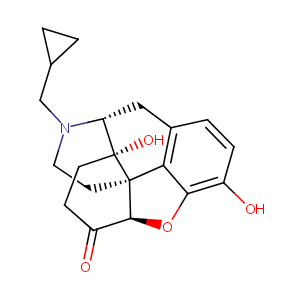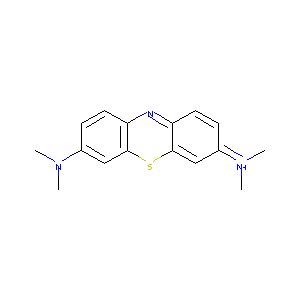| 1 |
Recurrent recessive mutation in deoxyguanosine kinase causes idiopathic noncirrhotic portal hypertension.Hepatology. 2016 Jun;63(6):1977-86. doi: 10.1002/hep.28499. Epub 2016 Mar 31.
|
| 2 |
Drugs@FDA. U.S. Food and Drug Administration. U.S. Department of Health & Human Services. 2015
|
| 3 |
FDA Approved Drug Products from FDA Official Website. 2019. Application Number: (ANDA) 074918.
|
| 4 |
Naltrexone FDA Label
|
| 5 |
URL: http://www.guidetopharmacology.org Nucleic Acids Res. 2015 Oct 12. pii: gkv1037. The IUPHAR/BPS Guide to PHARMACOLOGY in 2016: towards curated quantitative interactions between 1300 protein targets and 6000 ligands. (Ligand id: 1639).
|
| 6 |
ClinicalTrials.gov (NCT04365985) Study of Immunomodulation Using Naltrexone and Ketamine for COVID-19. U.S. National Institutes of Health.
|
| 7 |
Recombinant Plasmodium falciparum glutathione reductase is inhibited by the antimalarial dye methylene blue. FEBS Lett. 1998 Feb 6;422(3):311-4.
|
| 8 |
ClinicalTrials.gov (NCT04370288) Clinical Application of Methylene Blue for Treatment of Covid-19 Patients. U.S. National Institutes of Health.
|
| 9 |
An evaluation of mu-opioid receptor (OPRM1) as a predictor of naltrexone response in the treatment of alcohol dependence: results from the Combined Pharmacotherapies and Behavioral Interventions for Alcohol Dependence (COMBINE) study. Arch Gen Psychiatry. 2008 Feb;65(2):135-44.
|
| 10 |
In vivo chronic exposure to heroin or naltrexone selectively inhibits liver microsome formation of estradiol-3-glucuronide in the rat. Biochem Pharmacol. 2008 Sep 1;76(5):672-9.
|
| 11 |
Low dose naltrexone therapy in multiple sclerosis. Med Hypotheses. 2005;64(4):721-4.
|
| 12 |
Chronic naltrexone treatment induces desensitization of the luteinizing hormone pulse generator for opioid blockade in hyperprolactinemic patients. J Clin Endocrinol Metab. 1995 May;80(5):1739-42. doi: 10.1210/jcem.80.5.7745028.
|
| 13 |
Association between the Stin2 VNTR polymorphism of the serotonin transporter gene and treatment outcome in alcohol-dependent patients. Alcohol Alcohol. 2008 Sep-Oct;43(5):516-22. doi: 10.1093/alcalc/agn048. Epub 2008 Jun 14.
|
| 14 |
Predicting the effect of naltrexone and acamprosate in alcohol-dependent patients using genetic indicators. Addict Biol. 2009 Jul;14(3):328-37.
|
| 15 |
Photoluminescence of CdTe nanocrystals modulated by methylene blue and DNA. A label-free luminescent signaling nanohybrid platform. Phys Chem Chem Phys. 2009 Jul 7;11(25):5062-9.
|
| 16 |
Curcumin ameliorates high glucose-induced acute vascular endothelial dysfunction in rat thoracic aorta. Clin Exp Pharmacol Physiol. 2009 Dec;36(12):1177-82.
|
| 17 |
Inhibition of the bioactivation of the neurotoxin MPTP by antioxidants, redox agents and monoamine oxidase inhibitors. Food Chem Toxicol. 2011 Aug;49(8):1773-81.
|
| 18 |
Identification of environmental chemicals that activate p53 signaling after in vitro metabolic activation. Arch Toxicol. 2022 Jul;96(7):1975-1987. doi: 10.1007/s00204-022-03291-5. Epub 2022 Apr 18.
|
| 19 |
Pharmacologic reductions of total tau levels; implications for the role of microtubule dynamics in regulating tau expression. Mol Neurodegener. 2006 Jul 26;1:6. doi: 10.1186/1750-1326-1-6.
|
| 20 |
Defenses against oxidation in human erythrocytes: role of glutathione reductase in the activation of glucose decarboxylation by hemolytic drugs. J Lab Clin Med. 1991 Apr;117(4):325-31.
|
| 21 |
Profiling the Tox21 Chemical Collection for Acetylcholinesterase Inhibition. Environ Health Perspect. 2021 Apr;129(4):47008. doi: 10.1289/EHP6993. Epub 2021 Apr 12.
|
| 22 |
ADReCS-Target: target profiles for aiding drug safety research and application. Nucleic Acids Res. 2018 Jan 4;46(D1):D911-D917. doi: 10.1093/nar/gkx899.
|
|
|
|
|
|
|


